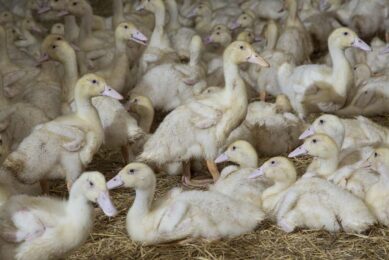Disease and ostrich confinement
Previously confinement was only for ostrich chicks (of all ages) at night to prevent them from getting too wet and developing hypothermia (Mitchell, 2001). However, the recent outbreaks of avian influenza have triggered a new reason for ostrich confinement, disease prevention (Huchzermeyer, 2006)
Previously confinement was only for ostrich chicks (of all ages) at night to prevent them from getting too wet and developing hypothermia (Mitchell, 2001). However, the recent outbreaks of avian influenza have triggered a new reason for ostrich confinement, disease prevention (Huchzermeyer, 2006 )
By confining ostriches indoors contact is avoided with wild birds, in particular waterfowl, which are possible sources of infection. An ostrich enclosure should be well lit, have sufficient space, allow the ostrich to look outside and facilitate guarding behaviour. It is important to realise that confining ostriches indoors is stressful for them but it is always preferable to losing them to avian influenza. Of course the need for confinement is dependent on the regulations set out by each country. European Union member states:
• After a suspected or confirmed case of avian influenza; protection/ surveillance zones and risk areas are formed which in turn justify temporary confinement. Without this exceptional situation, confinement could be classed as suffering for the ostriches, which is not allowed by European Convention for the protection and keeping of animals for farming purposes.
• There have been no cases or risk areas formed where strategies have been suggested for avoiding confinement; such as, permitting preventive vaccination, considering the ostrich as a rare or exotic bird or applying a surveillance programme with serological test samples.
Currently there is no exceptional scientific data on vaccinations in ostriches and any extrapolation from data on other species should be accompanied by preliminary studies. There has only been one trial in ostriches using commercial unspecific vaccines to determine the immune response as measured by serology (HI-method) and not correlated with protective immunity. It was concluded from this trial that vaccination did not produce specific immune protection. So the discussion is now, if the possible effectiveness of vaccination can be due to a much higher amount of infectious virus required to produce infection after induced resistance.
Ostrich producers believe that vaccination is of great importance because of the difficulties involved with indoor confinement, but in the EU vaccination may result in regional or total suspension of export for ostrich products. In Northern Spain there has only been one confirmed case of waterfowl (Podiceps cristatus) with avian influenza that was in 2006. A risk area was formed locally and preventive vaccination was not applied. Whereas, in Central Spain, Madrid, forced confinement of birds in backyard farms and parks was implemented. Fortunately for ostriches, forced confinement was not implemented; serological samples were taken and tested for avian influenza.
Note: Improve your facilities – see Recommendation Concerning Ratites 1997 , appendix 6; place water and feed troughs inside to avoid contamination from feeding wild birds, also be on the alert for signs of infection for example the excretion brilliant green urine.
Question: In the event of an avian influenza outbreak, can you suggest, other than those mentioned above, other strategies to avoid ostrich confinement?
Join 31,000+ subscribers
Subscribe to our newsletter to stay updated about all the need-to-know content in the poultry sector, three times a week. Beheer
Beheer








 WP Admin
WP Admin  Bewerk bericht
Bewerk bericht